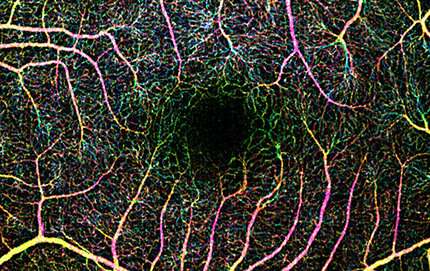Researchers develop a new method that could save diabetes patients from diabetic retinopathy

More than 7.7 Americans suffer from diabetic retinopathy, the leading cause of blindness in American adults, according to the National Eye Institute at the National Institutes of Health. However, current diagnostic methods are invasive and inconvenient, causing half of afflicted patients to forgo eye exams, oblivious to their advancing disease until it's too late to receive sufficient treatment.
Researchers in the Translational Imaging Center, a joint venture between USC Dornsife and USC Viterbi School of Engineering, are improving optical coherence tomography (OCT), a system that quickly and non-invasively images the retina to simplify the diabetic retinopathy screening process.
Scott Fraser, Provost Professor at USC Dornsife, Children's Hospital Los Angeles, the Keck School of Medicine of USC and USC Viterbi, and Jeff Fingler, senior scientist at the Translational Imaging Center, are leading the work, which could help the 50 percent of unidentified patients begin treatment earlier while simultaneously easing the workload of busy ophthalmologists.
"The majority of people on diabetes medications are not screened [for diabetic retinopathy] often enough. There are definitely more diabetic patients now than there were a decade ago, but there's not many more ophthalmologists, so that's a mismatch," said Fraser, who also is USC's director of science initiatives.
Diabetic retinopathy stems from damage to blood vessels in the light-sensing tissue layer, called the retina, that rests at the back of the eye. When screening patients for it, doctors check for any changes in blood vessels, including leakage, swelling, missing vessels or growths.
An invasive, expensive process
Traditionally, patients are diagnosed using fluorescein angiography, a drawn-out and invasive process. Patients are injected intravenously with fluorescein, a dye that makes their blood brightly fluorescent, so their blood vessels glow green when illuminated with a blue light.
After the dye reaches the eye, the subject must stare into an instrument that subjects them to bright flashes of blue light for several minutes. Fluorescein angiography's combination of bright flashes and eye dilation impacts patients' vision for the rest of the day.
"[This method] has been used for over 50 years," Fingler said, "but it's expensive, complicated and too invasive to be used as a screening tool, so doctors only use it for people who they already know have eye problems, preventing them from catching people at the earliest stages of the disease."
With diabetic retinopathy, catching the disease at the earliest stages is crucial. Most treatments cannot reverse the damage done; they only can prevent future damage. By making the screening process accessible to diabetic patients who are at risk for diabetic retinopathy, Fingler's and Fraser's improved screening system will help more patients receive adequate treatment and save some from blindness.
Described by Fraser as "an optical equivalent of an ultrasound machine," OCT was originally invented by Keck School of Medicine Dean Carmen A. Puliafito.
Seeing the light
Infrared light, which is not visible to the human eye, travels through an interferometer, which splits the light into two beams: one that is shined though the pupil and recollected after it reflects back from the retina; the other is bounced off a simple mirror. By comparing the two reflections with a spectrometer, which measures the color of the light, the image of a virtual slice through the retina is created.
The entire OCT-angiography process only requires seconds, compared with the fluorescein method's 10 minutes, and it screens patients without the inconvenience of injections and dilations or the intense blue flashing light. The USC team hopes that the speed, comfort and simplicity of their screening process will increase the compliance of diabetic patients being screened for diabetic retinopathy.
"OCT is already used by ophthalmologists all the time," Fingler said. "We want to enhance the instrument so that we can easily make it a more widely acceptable angiography method that is available to the masses."
While OCT itself isn't new, Fingler's and Fraser's idea for its application is. The two hope to make OCT screening stations available in pharmacies, akin to blood pressure monitors frequently found in drug stores.
"If these instruments were in pharmacies, patients could pick up their medications and look into the machine, making screening [for diabetic retinopathy] more of an everyday thing," Fraser said.
This would effectively alleviate two major problems surrounding treatment of diabetic retinopathy. First, placing devices in local pharmacies would make screening easier, lessening the number of undiagnosed patients. Additionally, moving the screening process from doctor's offices to pharmacies would give ophthalmologists more time to spend with higher-risk or already diagnosed patients—time that is increasingly valuable given the large gap between supply and demand of ophthalmologists.
A shortage of eye expertise
Although there are currently more than 200,000 ophthalmologists worldwide, there is an anticipated shortage of ophthalmologists in both developed and developing countries, according to the International Council of Ophthalmology.
Developing countries simply lack significant numbers of ophthalmologists; the population over the age of 60 is growing at twice the rate of the growth in the ranks of ophthalmologists. This means more patients, without an adequate increase in doctors, in those countries.
"Taking the primary diagnostics out of the ophthalmologist's office allows doctors to spend more time actually treating the disease, instead of screening people who are actually healthy," Fingler said.


















